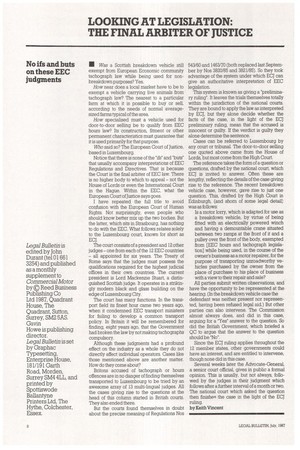No ifs and buts on these EEC judgments
Page 98

If you've noticed an error in this article please click here to report it so we can fix it.
• Was a Scottish breakdown vehicle still exempt from European Economic community tachograph law while being used for nonbreakdown purposes? Yes.
How near does a local market have to be to exempt a vehicle carrying live animals from tachograph law? The nearest to a particular farm at which it is possible to buy or sell, according to the needs of normal averagesized farms typical of the area.
Flow specialised must a vehicle used for door-to-door selling be to qualify from EEC hours law? Its construction, fitment or other permanent characteristics must guarantee that it is used primarily for that purpose.
Who said so? The European Court of Justice, based in Luxembourg.
Notice that there is none of the "ifs" and "buts' that usually accompany interpretations of EEC Regulations and Directives. That is because the Court is the final arbiter of EEC law. There is no higher body to which to appeal not the House of Lords or even the International Court in the Hague. Within the EEC, what the European Court ofJustice says goes, I have repeated the full title to avoid confusion with the European Court of Human Rights. Not surprisingly, even people who should know better mix up the two bodies. But the latter, which sits in Strasbourg, has nothing to do with the EEC. What follows relates solely to the Luxembourg court, known for short as ECJ.
The court consists of a president and 12 other judges one from each of the 12 EEC countries all appointed for six years. The Treaty of Rome says that the judges must possess the qualifications required for the highest judicial offices in their own countries. The current president is Lord Mackenzie Stuart, a distinguished Scottish judge. It operates in a strikingly modern black and glass building on the edge of Luxembourg City.
The court has many functions In the transport field its finest hour came two years ago, when it condemned EEC transport ministers for failing to develop a common transport policy. In Britain it will be remembered for finding, eight years ago, that the Government had broken the law by not making tachographs compulsory.
Although these judgments had a profound effect on the industry as a whole they do not directly affect individual operators. Cases like those mentioned above are another matter. How do they come about?
Britons accused of tachograph or hours offences are in no danger of finding themselves transported to Luxembourg to be tried by an awesome array of 13 multi-lingual judges. All the cases giving rise to the questions at the head of this column started in British courts. They also ended there.
But the courts found themselves in doubt about the precise meaning of Regulations Nos 543/60 and 1463/70 (both replaced last September by Nos 3820/85 and 3821/85). So they took advantage of the system under which ECJ can give an authoritative interpretation of EEC This system is known as giving a "preliminary ruling', It leaves the trials themselves totally within the jurisdiction of the national courts. They are bound to apply the law as interpreted by ECJ, but they alone decide whether the facts of the case, in the light of the ECJ preliminary ruling, mean that the accused is innocent or guilty. If the verdict is guilty they alone determine the sentence.
Cases can be referred to Luxembourg by any court or tribunal. The door-to-door selling one quoted above came from the House of Lords, but most come from the High Court.
The reference takes the form of a question or questions, drafted by the national court, which ECJ is invited to answer. Often these are lengthy, reflecting the details of the case giving rise to the reference. The recent breakdown vehicle case, however, gave rise to just one question. This, drafted by the High Court in Edinburgh, (and shorn of some legal detail) was as follows: Is a motor lorry, which is adapted for use as a breakdown vehicle, by virtue of being fitted with an electrically powered winch and having a demountable crane situated between two ramps at the front of it and a pulley over the front of the body, exempted from [EEC hours and tachograph legislation] while being used, in the course of the owners business as a motor repairer, for the purpose of transporting unroadworthy vehicles purchased by the owner from the place of purchase to his place of business with a view to their repair and sale?
All parties submit written observations, and have the opportunity to be represented at the hearing. (In the breakdown vehicle case the defendant was neither present nor represented, having been refused legal aid.) But other parties can also intervene. The Commission almost always does, and did in this case, arguing for a "Yes" answer to the question So did the British Government, which briefed a QC to argue that the answer to the question should be "No'.
Since the ECJ ruling applies throughout the 12 member states, other governments could have an interest, and are entitled to intervene, though none did in this case.
Several weeks later the Advocate-General, a senior court official, gives in public a formal opinion. This is usually, but not always, followed by the judges in their judgment which follows after a further interval of a month or two. The national court which asked the question then finishes the case in the light of the ECJ ruling, by Keith Vincent




































































































